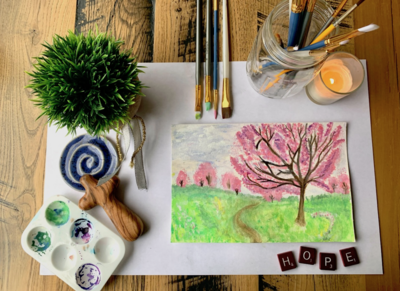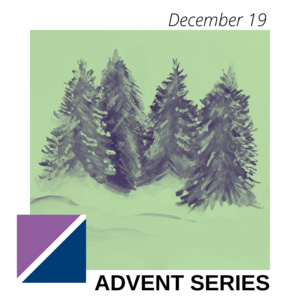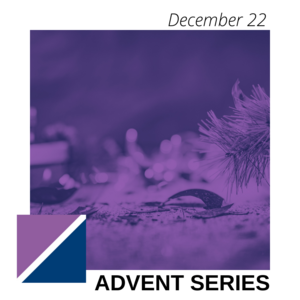2021 Advent Devotional
Join Andover Newton for a devotional during Advent 2021. We are sharing a few posts each week that celebrate the creativity and diversity of this beloved community. You never know what you’ll receive from post to post. We’ll have paintings, images, and an Advent yoga meditation.
In this broken and beloved world, there is a particular beauty in this season of expectation. As we stand on the vista and look out toward Christmas morning, we’ll make intentional stops along the way. Like the wisdom gained from traditional pilgrimage, this journey will become its own destination.
Posts will originate on Facebook (@andovernewton) and Instagram (@Andover_Newton) and will then be curated together on this page. We hope that you’ll find this creative path filled with sustenance, diverse interpretations, and loving guides.
For faculty, staff, and others who will be on campus, you will be able to see the Andover Newton Advent Calendar physically unfold on our bulletin board outside of the main office suite (N200). Stop by, meditate, and be nourished…
Reflections for Advent 2021
Video introduction to the series…
Advent Reflection for November 28, 2021 by second year student Lydia Hoffman

Advent reflection for November 30, 2021 by third years students Jyrekis Collins and Mike Gordon
Advent reflection for December 2, 2021 by third year student I’noli Hall.
Reflection for the second Sunday in Advent by second year student lydia hoffman.

This creation for the second week of Advent by 2nd year student Lauren Dubé.
 When I look at a piece of fiber art, whether it’s crocheting, knitting, embroidery or weaving, the thing that stands out to me most is not the colors, or the material, but each and every small, intricate stitch. Each project is made up of thousands of stitches, and this wreath has well over 4,000 stitches alone. When I start a project, each stitch feels massive and important. With just six stitches, I can see the project begin to take shape and grow. However, once I get a few rows into the project, each stitch feels more and more miniscule, as if it makes less of a difference.
When I look at a piece of fiber art, whether it’s crocheting, knitting, embroidery or weaving, the thing that stands out to me most is not the colors, or the material, but each and every small, intricate stitch. Each project is made up of thousands of stitches, and this wreath has well over 4,000 stitches alone. When I start a project, each stitch feels massive and important. With just six stitches, I can see the project begin to take shape and grow. However, once I get a few rows into the project, each stitch feels more and more miniscule, as if it makes less of a difference. Advent reflection for December 10, 2021 from second year MDiv student Kevin Marsh.
 Finding a faith that was ripped from your grasp is never an easy journey. However, it is one that I immediately embarked upon. The joy of the journey to find God in the midst of the cloudy ethereal mist of one’s soul is that God will inevitably manifest. And in my case, God’s presence found me in the most unlikely of art forms, drag, the passion of a lip sync mimicking the passion of the worship leaders who deemed me unfit to lead, the ornate pageantry reflecting the iconography of the church, and the crude jokes and messages of self-love transfixing me as they morphed into the most beautiful of homilies. In that moment, I found it. Emmanuel: God with me. There is a subversive beauty of God’s presence being made manifest in the societally obscene. Whether that is the humble beginnings of a barnyard childbirth or the grunge of a midwestern gay bar, God seems to consistently choose to be made manifest in places that can only be understood as the comedy of divine irony.
Finding a faith that was ripped from your grasp is never an easy journey. However, it is one that I immediately embarked upon. The joy of the journey to find God in the midst of the cloudy ethereal mist of one’s soul is that God will inevitably manifest. And in my case, God’s presence found me in the most unlikely of art forms, drag, the passion of a lip sync mimicking the passion of the worship leaders who deemed me unfit to lead, the ornate pageantry reflecting the iconography of the church, and the crude jokes and messages of self-love transfixing me as they morphed into the most beautiful of homilies. In that moment, I found it. Emmanuel: God with me. There is a subversive beauty of God’s presence being made manifest in the societally obscene. Whether that is the humble beginnings of a barnyard childbirth or the grunge of a midwestern gay bar, God seems to consistently choose to be made manifest in places that can only be understood as the comedy of divine irony. advent reflection for December 12, 2021 by second year student lydia hoffman.
Advent reflection for December 14, 2021 by second year student meredith barges
 A time of wonder and hope comes alive in the details of how the infant Jesus came to lay peacefully in a manger in Bethlehem.
A time of wonder and hope comes alive in the details of how the infant Jesus came to lay peacefully in a manger in Bethlehem.Advent Reflection for December 17 comes from 2nd year student Benjamin Geeding.
 Waiting can be terrible. Uncertainty, unsure, unmoored. Holding out for something which may or may not be good.
Waiting can be terrible. Uncertainty, unsure, unmoored. Holding out for something which may or may not be good. advent reflection for december 19 comes from 2nd year student lydia hoffman.
 Love
LoveAdvent reflection for Solstice (December 21) comes from 2nd Year Student Tasha Brownfield.
Advent reflection for december 22 is a wonderful review of our advent series thus far by its coordinator and curator, 2nd year MDiv student Christine Geeding.
 You’ve heard from many Andover Newton students over the past four weeks, which may feel disjointed, even broken apart from one another.
You’ve heard from many Andover Newton students over the past four weeks, which may feel disjointed, even broken apart from one another. Advent reflection for Dec. 25th - the Christ candle - comes from Ned Allyn Parker (MDiv ‘10).
 Something was askew in the scattered skyscape.
Something was askew in the scattered skyscape.
